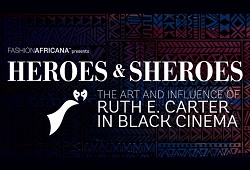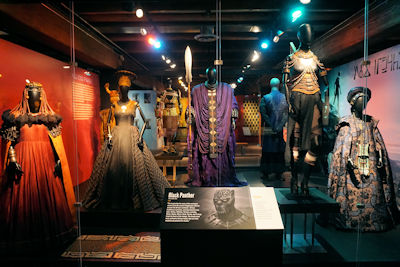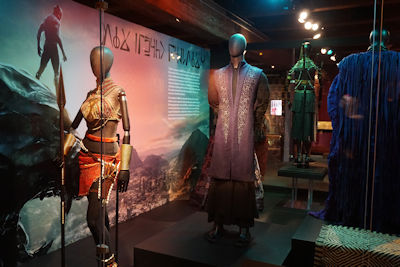
On February 24, 2019, Black Panther became the first film from the Marvel Cinematic Universe to win an Academy Award. While that alone may have been cause for celebration among fans of superhero movies, two of the three Oscars snagged by Black Panther were of historical importance for more compelling reasons, including Hannah Beachler becoming the first African American to receive an Academy Award for Best Production Design.
Shortly before Beachler’s groundbreaking achievement, Ruth E. Carter was presented with the Oscar for Best Costume Design. Black Panther was Carter’s third Academy Award nomination, having received previous nods for her work on Malcolm X and Amistad. In addition to being the first Oscar win for Marvel, it was the first for an African American woman in the Best Costume Design category as well.
It was also a long overdue acknowledgement of Ruth Carter’s accomplishments within the film industry during a career that has spanned over three decades. The Oscar triumph followed recognition of a different sort at the Senator John Heinz History Center in Pittsburgh, which premiered an exhibit of costume designs from Carter’s thirty years in the industry entitled Heroes and Sheroes: The Art and Influence of Ruth E. Carter in Black Cinema.
The exhibit – which opened on August 25, 2018, and ran through December 2, 2018 – featured original costumes and jewelry from such noteworthy motion pictures as Amistad, What’s Love Got to Do with It, Malcolm X, Do the Right Thing, and yes, Black Panther. Heroes and Sheroes did more than showcase the clothes worn in the above mentioned films, however, as it also followed the design process of Ruth Carter and how she meticulously constructs the costumes to reflect both the subject matter and atmosphere of each production.
“We used African fabrics to punctuate the pop culture fashion and the community of Brooklyn being a major cultural hub of the African diaspora,” Carter explains of Do the Right Thing. “Tops made using African fabric were created, and saturated colors reflected the intensity of the story and the hottest day of the year. Radio Raheem’s outfit reflected the avant-garde style of hip hop Brooklyn, where his shirt was painted by a local artist. It represented the neighborhood he resided in as well as the tone of pop culture at the time.”
Ruth Carter researched historical time periods for other films, including Amistad, Malcolm X and the 2016 remake of Roots. During preproduction for Amistad, for instance, she studied the cargo list of Spanish slave traders before deciding to wrap the African captives in blankets and turbans. Carter also petitioned the Massachusetts Department of Corrections for access to the former Malcolm Little’s file while working on Malcolm X in order to gain additional insights into the Civil Rights icon.
“Indigo features strongly throughout the story,” Carter offers in regards to Roots. “This was a dye used in Africa for its vibrant color but also for its chemical properties, such as an insect repellant. We knew from the beginning that because they harvested indigo in the Juffure village in Africa, they would have these rich blue articles of clothing. Over the course of the story, blue became the family color, which you can trace back to the indigo of Juffure.”
Then there’s Black Panther, which served as the centerpiece of the exhibit and featured costumes worn by Chadwick Boseman (T’Challa), Angela Bassett (Ramonda), Forest Whitaker (Zuri), Danai Gurira (Okoye), and Letitia Wright (Shuri). Artwork from Ruth Carter’s design process was also showcased, as well as traditional beads from various factual African tribes.
The indigenous cultures of Africa played a significant role in the creation of the costumes showcased in Black Panther, including the Zulu, Himba, Ndebele, Turkana, Lesotho, Dinka, Dogon, Mursi, Sami, Surma and Tuerag tribes. Carter likewise added elements of Afrofuturism to her designs to reflect the intersection of tradition with the technological advancements of Wakanda, making Black Panther a reflection of both the past and the future in the process.
In many ways, the groundbreaking Black Panther is a fitting representation of Ruth Carter’s work over the past thirty years, the culmination of a lifetime endeavor to bring the African American experience to life. The films that Carter has been part of were not standalone images reflected on a screen but collectively tell a story that takes place over the course of centuries. Just as Black Panther is more than a superhero flick, Heroes and Sheroes is more than an assortment of costumes but an authentic reflection of the times that each of the films represent.
From the generational narrative of Roots to the slave revolt of Amistad, from the Civil Rights Era Selma and Malcolm X to the cultural impact of the Motown sound in Sparkle, from the lifetime reflections of The Butler to Spike Lee’s Do the Right Thing, the African America experience – the good, the bad and the ugly – were all on display within Heroes and Sheroes, making the exhibit an historical testament as much as anything else.
“I’ve been dressing superheroes my whole career,” Ruth E. Carter muses in the introduction to Heroes and Sheroes. “Martin Luther King, Jr., was a superhero. Thurgood Marshall was a superhero. Tina Turner and others are superheroes.” The same can be said of Carter herself, who has both the Oscar and career retrospective to prove it.
Anthony Letizia





